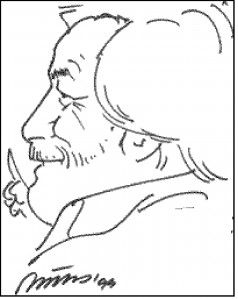John Marshall Roberts. Igniting Inspiration: A Persuasion Manual for Visionaries. Transformational Design, 2008.
 One of the challenges people steeped in theory and ideas have is learning to successfully communicate with those who hold different theories or ideas. Another is to communicate with those who don’t give a fig for either theories or ideas different from their own. Certainly one of the promises of exploring psychological theories and models, and particularly adult developmental psychology, is that it will lead to an understanding of self and others in relation to ego development, psychosocial development, values development, and worldview variability. This is where John Marshall Roberts comes in.
One of the challenges people steeped in theory and ideas have is learning to successfully communicate with those who hold different theories or ideas. Another is to communicate with those who don’t give a fig for either theories or ideas different from their own. Certainly one of the promises of exploring psychological theories and models, and particularly adult developmental psychology, is that it will lead to an understanding of self and others in relation to ego development, psychosocial development, values development, and worldview variability. This is where John Marshall Roberts comes in.
Roberts presents a set of ideas and models to “socially conscious marketers, business leaders, and activists who believe that communication should serve life and not the other way around” (1). He goes beyond mere communication to what his title states: giving us an approach for inspiring others. To use symbols and images to accomplish this, we need to have a framework, a meta context, to guide us.
Communication with all elements and domains in our society is going to realize increasing traction. This will help bridge differences, evolve visions, and take effective action as we move forward in addressing our challenges, as well as developing our abilities to make the “spiral healthy.” This book is in great alignment with the work that Don Beck and his associates have been doing in various parts of the world and various domains; from business to government, to communities, to engaging many domains to address economies, cultures and sustainability. This is an important book.
Beginning with the notion that human beings are multidimensional (mind, body, and spirit as a basic set of facets), inspiring and persuading others must address this multidimensionality to facilitate generative potential. Roberts indicates that this means one must be a great communicator. “A great communicator is someone who liberates people from these rigid mental havens and helps the smoke clear. A great communicator understands that all mental forms are spiritual prisons and gently invites us to unlock the doors and step outside to a world where infinity is a fact, and scarcity an illusion. Inspiration is the feeling of freedom and joy from realizing that who we are is beyond the body, and beyond all limiting beliefs.”
As I read and reread these lines, I must admit that I became concerned that this was just another book of New Age-y postulates and commandments. At the very least, perhaps, a bit of spiritual overload in search of worldly action. Skeptic that I am, I inferred that the author clearly thinks I am a pig he cannot teach to sing. Yet, he provides some amusing alternative concepts that save me from the spiritual slaughterhouse.
At its core this book is about inspiration. To inspire means not only getting pigs like me to let our guard down, but to communicate in a way that speaks to the pig’s heart – well, soul – and worldview. To do this means getting very, very practical. Getting practical about inspiration offers the best hope for leverage; even in the face of cynicism, despair, and resignation that may take over in the face of the extraordinary challenges we face as members of communities, nations, and the world.
Roberts has been inspired, despite some differences and disconnects, by the work of Clare Graves, as well as by Beck’s and Cowan’s Spiral Dynamics. One thing he has in common with Don Beck is a foundational concern for design. Inspiring others requires engaging body, mind, and spirit. There is a design goal for each of these. With body, capture the attention. With Mind, engage interest. With spirit, transcend thought. This involves breaking through the filters at each point of engagement by effective communication. Capturing attention requires meeting people at the place of their values. Engaging interest requires connecting to what is important for people. Here we find suggestions for the use of a lot of tools–from situational framing to storytelling–each a device for connecting to others.
Transcending thought requires us to have people experience the message differently, particularly to suspend judgment. This requires developing trust and addressing core assumptions that we can understand in relation to mindset or stage in adult development, particularly as represented by spiral dynamics.
All of this effort is to work toward transformation–physical, mental, and spiritual. In regard to transformation Roberts writes, “The hidden truth that all great communicators understand is that we do not inspire people by trying to make them better, we inspire them by witnessing their inherent perfection.”
Roberts offers ten universal principles of inspiration Number eight is, “A sender’s own intentions infuse the message with a quality that calls for a similar matching frequency in the receiver. This is the law of resonance.” This is the idea that we must learn to communicate clearly and effectively to individuals with diverse worldviews and mindsets. At this point the book draws on the work of Clare W. Graves and parallels spiral dynamics. Let me be clear: this is not spiral dynamics. Roberts has studiously avoided the risk of being subject to a lawsuit over the contention among SD theorists. He uses Graves’ types of thinking that have evolved and points out the parallels in the color scheme of spiral dynamics. He emphasizes that each level of development represents an increase in cognitive complexity. His treatment is well worth the read since it lays out tips for communicating with those whose development is centered in any one of the states. As an example, Roberts offers tips for inspiring those centered in blue:
- Design messages to resonate with blue sensibilities;
- Engage “moral issues and the presence of legitimate authority;” and
- Reframe “their experience into something more inspiring and profound.”
When addressing a group of people, it is rare for all members of that group to have the same “center of gravity.” Most are going to be centered in what spiral dynamics calls red, blue, orange and green. I like the way he has framed three of these:
Blue Serves Purpose
Orange Serves Profit
Green Serves People
I would add that Red serves self. Roberts adds that Yellow serves planet. Here is where things get really interesting. Because of the diversity in groups, those who wish to inspire or to lead must find a way to deliver their messages so that they are valued by many of the members of the group. Roberts calls this “scaled messaging.” The purpose is to guide the members of the audience toward a different “bottom line” that can be more or less complex. He states, “Basically scaled messaging involves leading the listener through a series of targeted questions, comments, and topics intended to hit at each of these bottom lines (planet, people, profit and purpose [and self]) in seamless, rhythmic succession.”
This is a very different way of framing the challenge than how I have understood it; to wit, the goal is to define and frame one’s message so that it resonates authentically with each of these “bottom lines.” Perhaps this is a fine distinction; but here we have a useful both/and opportunity in that there is a process, an intention or aspiration, and a message–or set of messages–designed to align a diverse group.
The book is replete with concrete methods and practices one can use to leverage the developmental framework and understanding at the heart of Roberts’ theories. It closes with a chapter on transformational design, thus reemphasizing the importance of design in how we are being and doing together. Roberts offers five steps:
- Clarify your intentions;
- Define the target audience;
- Create a prototype;
- Clean it up; and
- Test it out.
Step 6 would be to learn from this process, and step 7 would be to revise one’s intentions and the other steps in the process.
Many are looking for practical ways to apply the concepts of integral, adult development and other models for inspiring and leading change. This book is a great place to find methods, practice them, and learn from the experience.


